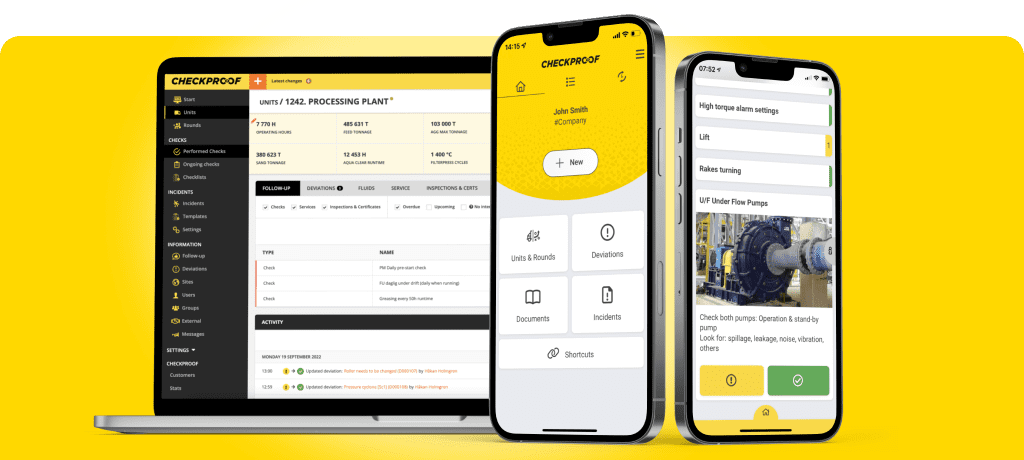Join us at AGG1, St Louis, MO - America's Center Convention Complex: 25-27 March
Within the Heavy Industry and particularly the Heavy Machinery segment, regulatory compliance is often not just a legal requirement, but a fundamental aspect of sustainable business practices. Whether you’re a manufacturer of heavy machinery or an operator, staying abreast of regulatory requirements is paramount to success. Failure to comply can result in severe consequences ranging from hefty fines to reputational damage and even operational shutdowns.
In this article, we walk you through how to stay on top of the dynamic regulatory landscape.
- Understanding the Regulatory Landscape in the Heavy Machinery Industry
- What are the Compliance Challenges in Heavy Industry?
- Top 7 tips for staying on top of Regulatory Compliance and Changes
- How CheckProof can help with Regulatory Compliance
Understanding the Regulatory Landscape in Heavy Machinery Industry
Regulations for the Heavy Machinery industry can come from various sources, including:
- Governmental bodies
- Industry organizations
- International directives and standards
There are several key components within the regulatory landscape that companies within the Heavy Industry need to understand to adopt and integrate best practices internally and ensure they stay compliant.
- Regulatory Frameworks: Regulatory Frameworks: Acquiring knowledge of local, national, and international regulations on safety, environmental protection, labour practices, and operational standards.
- Industry Standards and Best Practices: Understanding industry-specific standards and best practices to promote operational excellence. This may involve adhering to standards set by organizations such as OSHA (Occupational Safety and Health Administration), EPA (Environmental Protection Agency), ISO (International Organization for Standardization), MPA (Mineral Products Association) and other industry-specific associations.
- Risk Assessment Analysis: Conducting thorough risk assessments to identify potential hazards and risks in heavy industry operations is crucial. Understanding how to minimize risks while complying with regulatory requirements will help ensure worker safety and operational continuity. Schedule to review these annually to maintain up to date records. This way any changes on-site or to the equipment won’t be missed.
- Documentation and Recordkeeping: Maintaining accurate documentation of equipment maintenance, safety inspections and reporting is a fundamental cornerstone of regulatory compliance in heavy industry. With CheckProof this process is simplified as it can all be carried out from one digital platform, where you can do your checks, but also keep all the reporting, easily sharing it between frontline and the office.
- Inspections: It may seem counterintuitive to have inspections to help understand the regulatory requirements but audits and inspections can help identify areas for improvement. Understanding how to conduct effective audits and inspections, as well as responding to findings and implementing corrective actions, is gold dust to keep on top of regulatory requirements.
What are the Compliance Challenges in the Heavy Industry?
Even if you have a strong grasp of how the regulatory landscape works in the Heavy Industry, compliance within this segment still poses numerous challenges, including:
- Diverse Regulatory Frameworks: Heavy industry companies must navigate a maze of regulations from different jurisdictions and different countries, each with its own requirements and deadlines.
- Continuous Updates: Regulatory standards evolve, necessitating ongoing monitoring and adaptation to remain compliant with the latest requirements.
- Resource Allocation: Compliance activities demand significant time, effort, and financial resources, sometimes diverting attention away from core business activities.
- Documentation Management: Maintaining accurate records and documentation to demonstrate compliance can be cumbersome, particularly for companies operating across multiple sites or regions. Keeping these records digitally will help fix this problem.
- Cross-functional Compliance Regulations: To keep all the wheels moving at the same time, so to speak, can be challenging in the Heavy industry. For example, companies often must ensure that both the on-site work environment as well as the equipment that staff are working with are fully compliant.
- Dynamic changes that require quick action: Recently Stiftelsen Sentralregisteret in Norway implemented regulatory requirements where they collect details on all Heavy Machinery on one digital platform. All to ensure operators can do a quick search to see if the Heavy Machine meets the required safety standards. This transparency benefits personnel on the field, but nevertheless requires agility on the part of the operators, to adapt and ensure their machinery is registered with vital data on ownership, maintenance, and safety certifications.
Top 7 tips for staying on top of Regulatory Compliance and Changes
Staying on top of regulatory compliance and changes to regulations can be a challenge. It typically requires a systematic and proactive approach. The tips shared below can help your company elevate its regulatory compliance practices and not be the last one to find out when regulations change!
- Schedule quarterly or monthly scans of websites that offer regulatory information pertinent to your industry.
- Subscribe to newsletters that help you stay in the loop with regulatory information delivered straight to your inbox. Examples of helpful sources that cover both regulatory developments and best practices for heavy machinery operators include Construction Equipment Association (CEA) Newsletter, OSHA QuickTakes Newsletter (The Occupational Safety and Health Administration offers the QuickTakes newsletter to provide updates on safety regulations), National Association of Manufacturers (NAM) Newsletter (this newsletter covers regulatory and policy updates affecting the manufacturing industry) and the Association of Equipment Manufacturers (AEM) Newsletter to name but a few.
- Designate either a member of staff (or assign a team that share the workload of keeping up with new legislation and staff training on new regulations.
- Training programs, webinars, and seminars are a great way to stay updated without having to spend a lot of time and effort on your end. For example, attending compliance training programs, you will be learning firsthand from subject matter experts.
- Industry associations and compliance community websites offer many opportunities to keep track of regulatory shifts.
- Implementing GRC (Governance, Risk & Compliance) software tools can help give regular updates on regulatory changes.
- Partner with experts or trusted advisors
How CheckProof can help with Regulatory Compliance
CheckProof offers heavy industry companies a powerful toolkit to tackle regulatory challenges effectively. Here’s how we can help:
- Centralized Compliance Monitoring: CheckProof provides a centralized platform to help you track regulatory requirements, transfer all your policies into one place and alert you to regulatory deadlines across all operations. The system gives you real-time visibility into your compliance preparation and allows for proactive risk management.
- Automated Regulatory Reporting: CheckProof automates data collection and report generation for compliance. This frees up time and minimizes the risk of human error.
- Customizable Workflows: CheckProof allows companies to create, customizable checklists and workflows tailored to their specific compliance needs. This flexibility enables seamless integration with existing processes and ensures alignment with regulatory standards.
- Document Management and Audit Trail: With CheckProof, companies can securely store and manage compliance-related documents, including certifications, calibrations, permits, licenses, inspection reports, and audit findings. The platform enables traceability and accountability throughout the compliance lifecycle.
- Real-Time Reporting and Analytics: CheckProof offers advanced reporting and analytics capabilities, automates data collection and reports, empowering companies to gain actionable insights into their compliance performance. These insights enable informed decision-making and continuous improvement initiatives.
In summary, regulatory compliance in the Heavy industry involves an understanding of regulatory frameworks, industry best practices, documentation, and risk-management principles. The complex web of regulations and standards is ultimately designed to safeguard worker safety and exercise sustainable business practices.
If staying on top of regulations shifts seems overwhelming, refer to the checklist above on what you can do to keep yourself informed.
Simply because when companies can ensure compliance, they will automatically mitigate risks, and promote a culture of safety and excellence.
Want to know what CheckProof can do for you?
CheckProof's easy-to-use app makes it easier to do the right thing at the right time. Discover how you can run world-class maintenance that is both cost-effective and sustainable.

Maximize Efficiency with an OEE Monitoring System

Plant Asset Management Software:Maximizing Equipment Uptime

Machine Downtime Tracking: The key to smarter, more efficient operations

CMMS Software: What it is and why it’s key to First-Class Maintenance Operations

Revolutionizing Compliance: Banner Contracts on managing ISO audits with CheckProof

Implementation of Digital Systems: Rolling Out CheckProof Across Teams

From Fuel Savings to Production Gains: Cemex Germany’s Wins with CheckProof

A Recap of the CheckProof Industry Event & 10th Anniversary Celebration

Trend Report: Key moments in the Construction Materials industry (2014–2024)




